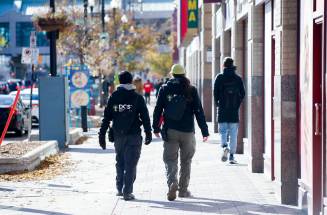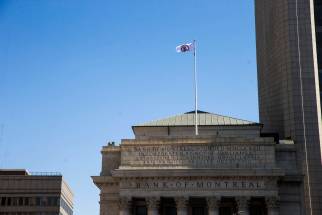Power to the people Urgent decision-making is needed on Winnipeg's downtown; advocates are calling for vulnerable populations to have a seat at the table
Read this article for free:
or
Already have an account? Log in here »
To continue reading, please subscribe:
Monthly Digital Subscription
$0 for the first 4 weeks*
- Enjoy unlimited reading on winnipegfreepress.com
- Read the E-Edition, our digital replica newspaper
- Access News Break, our award-winning app
- Play interactive puzzles
*No charge for 4 weeks then price increases to the regular rate of $19.00 plus GST every four weeks. Offer available to new and qualified returning subscribers only. Cancel any time.
Monthly Digital Subscription
$4.75/week*
- Enjoy unlimited reading on winnipegfreepress.com
- Read the E-Edition, our digital replica newspaper
- Access News Break, our award-winning app
- Play interactive puzzles
*Billed as $19 plus GST every four weeks. Cancel any time.
To continue reading, please subscribe:
Add Free Press access to your Brandon Sun subscription for only an additional
$1 for the first 4 weeks*
*Your next subscription payment will increase by $1.00 and you will be charged $16.99 plus GST for four weeks. After four weeks, your payment will increase to $23.99 plus GST every four weeks.
Read unlimited articles for free today:
or
Already have an account? Log in here »
Hey there, time traveller!
This article was published 18/10/2022 (1146 days ago), so information in it may no longer be current.
In the waning days of 2019, it seemed to Kate Fenske as if downtown Winnipeg would ride into the new year on a fresh wave of momentum. New development was in the works, including plans for more housing. Twice as many businesses had opened that year than closed, and the Downtown BIZ CEO was optimistic the area’s fortunes were shifting.
Then COVID-19 swept over the world and everything changed.
For years, downtown’s business strategy had leaned on two pillars: big events, and the roughly 60,000 people that went to work there every day. But suddenly, the office workers had vanished. There were no more concerts and Jets games. The restaurants and shops that served those crowds saw revenues crater; the streets fell silent, even by day.
At the time, the BIZ threw itself into helping its businesses survive. It wasn’t always enough. On a crisp recent afternoon, as Fenske strolls down Graham Avenue, she points at a string of storefronts that once housed a framing store, a niche café and a coffee shop. All three sit empty now, joining downtown’s 32 per cent ground-floor vacancy rate.
“We’re seeing a lot of change right now,” Fenske says. “But I think that’s OK.”
MIKE DEAL / WINNIPEG FREE PRESS Winnipeg has a big downtown — it contains some 300 blocks — and if its future is to be more vibrant than its past, it has to take a much different approach, Downtown BIZ CEO Kate Fenske believes.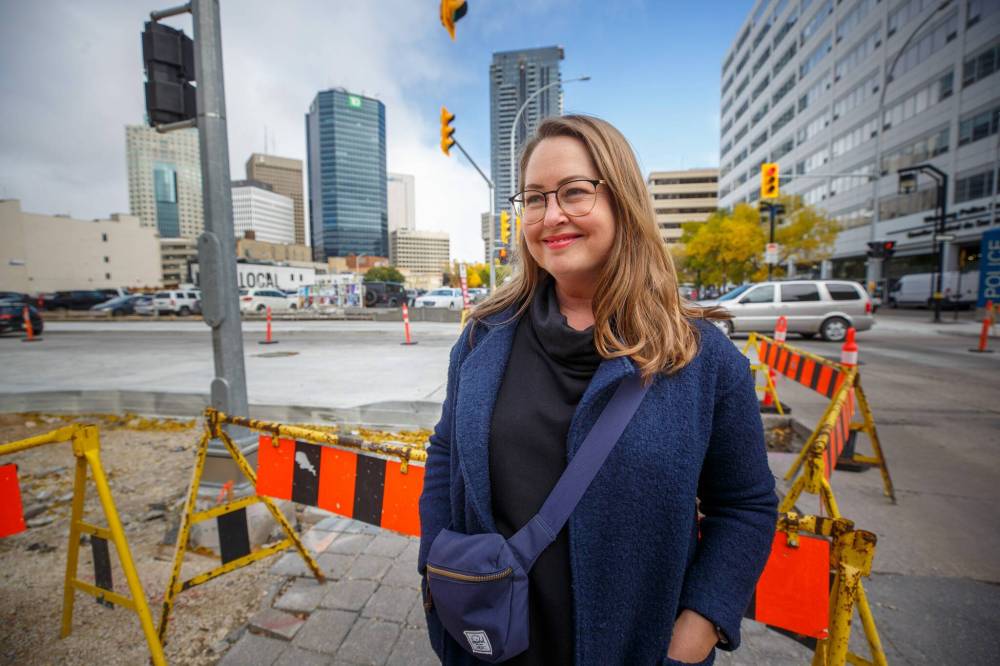
What she means is that, 2 1/2 years into the pandemic, downtown is starting to get back on its feet. So far, 15 new businesses have opened in 2022, although more than that have closed. The former coffee shop on Graham has already been leased; about 64 per cent of daytime workers are back in the office, though not always five days a week.
Change is coming. A new 42-storey luxury apartment tower at 300 Main is almost ready for renters. Posh steakhouse 529 Wellington will open a Portage and Main location. The Devil May Care brewpub is set to open on Fort Street next month, and the BIZ is preparing to launch a program that will provide key financial support to new businesses.
Shifting attitudes
A significant majority of Winnipeggers support strategies to alleviate homelessness and addiction, with safe consumption sites, more shelter spaces, more mental-health workers and designated camp areas for unhoused people all drawing a significant-sized positive response in a new Probe Research poll.
The telephone survey of 600 adults, conducted last month for the Free Press and CTV Winnipeg, sought to get a sense of how Winnipeggers felt about a variety of approaches advocates for unhoused people have been calling for to address the rising challenges facing the city’s most vulnerable populations.
A significant majority of Winnipeggers support strategies to alleviate homelessness and addiction, with safe consumption sites, more shelter spaces, more mental-health workers and designated camp areas for unhoused people all drawing a significant-sized positive response in a new Probe Research poll.
The telephone survey of 600 adults, conducted last month for the Free Press and CTV Winnipeg, sought to get a sense of how Winnipeggers felt about a variety of approaches advocates for unhoused people have been calling for to address the rising challenges facing the city’s most vulnerable populations.
Of the four strategy proposals, hiring more mental-health workers and opening more shelter spaces were overwhelmingly embraced by poll respondents, with a respective 94 per cent and 92 per cent in favour. Just over eight in 10 supported the idea of creating safe consumption sites, while 78 per cent expressed some support for designated encampments.
There were a number of notable demographic differences. Support for safe consumption sites was highest among women (65 per cent), younger adults (71 per cent), NDP voters (81 per cent) and residents of the city’s core neighbourhoods (78 per cent). It was lower among men (53 per cent), adults over age 55, (50 per cent), and southwest residents (51 per cent).
Roughly one in four people who identified themselves as Progressive Conservative supporters were in favour.
While designated encampments had less overall support than safe consumption sites, the demographic breakdown followed the same trends. In both cases, homeowners were less likely to support the strategy than renters. Black, Indigenous and other racialized people were more likely to be in favour than their white counterparts.
The results, according to Probe principal Mary-Agnes Welch, reflect an ongoing transformation in how Winnipeggers see the best ways to address some of the city’s most entrenched problems.
“When you ask Winnipeggers ‘What is your biggest concern?’ overwhelmingly it is poverty, homelessness and crime,” Welch told the Free Press.
“What we’ve seen over the last five years to a decade is a shift away from a get-tough approach, a hire-more-cops approach to homelessness and poverty, and towards a root-causes approach.
“Building affordable housing, dealing with mental-health issues and addictions treatment… there’s been this ideological shift among Winnipeggers that we’ve seen. So the data now digs a little deeper at that.”
melissa.martin@freepress.mb.ca
Then there’s the project that, though far from completion, could be one of the most significant in the core area’s history: the $130-million transformation of the Hudson’s Bay building into an Indigenous-owned, multi-use space that will include two restaurants, a museum, a health and healing centre and a governance house for the 34 southern First Nations.
So maybe those things help bring some optimism about downtown’s future. Yet the starkest lesson of the pandemic lingers: the old pillars of office workers and big events aren’t enough. Winnipeg has a big downtown — it contains some 300 blocks — and if its future is to be more vibrant than its past, Fenske believes, it has to take a much different approach.
“We’d be silly if we anticipated all workers to come back five days a week and our downtown to be OK,” she says. “I think the pandemic has really forced us to really look at who does our downtown serve, who was already here, who might want to come here and what was its purpose?”
These aren’t new problems; for decades, the city’s downtown has struggled. As Winnipeg sprawled, the suburbs spun out from the core, draining residents and visitors. Sadness permeated, settling over neglected blocks, shuttered shops and surface parking lots, the “buildings gone missing like teeth” of the famous Weakerthans song.
For years, Winnipeggers pinned much of their hopes for downtown revival on buildings. Big projects. When Portage Place opened in 1987, it was supposed to save downtown; in 2004, the same hope was pinned on the opening of the arena, now called Canada Life Centre; later, the saviour was to be the Manitoba Hydro tower. Yet the decay still nibbled.
“I think the thing that we’ve missed when we’ve relied on one property to be the game-changer is, it doesn’t work that way,” Fenske says. “Cities don’t work that way. It’s about creating a community and a neighbourhood for people, and we haven’t done that. We haven’t started with a people-first approach to building our city.”
For instance, Fenske points out, the downtown is bracketed by some of Winnipeg’s most beloved attractions: The Forks on one side, the Winnipeg Art Gallery on the other. Yet the walk between them is patchy, largely devoid of thriving community space. Broadway could be an appealing thoroughfare, for instance, but it was designed mostly for cars.
“It’s about creating a community and a neighbourhood for people, and we haven’t done that. We haven’t started with a people-first approach to building our city.”–Kate Fenske
So if downtown is to become truly vibrant, it needs to start by becoming a good place for people, she says. Winnipeggers don’t tend to think of downtown as a neighbourhood in the way they do other regions: but thousands of residents live in the area. During the pandemic, they’re the ones who remained. So maybe, rethinking downtown should start there.
“I think the thing that’s happened the last two years, we’ve been trying to put all these pieces of the puzzle together, and the puzzle that we’re trying to get to has actually changed,” Fenske says. “So we need to start with some new pieces, and figure out what that image in the end is actually going to look like. And it starts with who’s here, and who wants to be here?”
The people who live downtown are diverse, along many factors. Seniors make up roughly one in four residents. Newcomers have built a growing community near Central Park. New luxury apartments draw high-earning professionals, while others find more affordable homes in the old character apartments closer to the Assiniboine River.
MIKE DEAL / WINNIPEG FREE PRESS Fenske points out the downtown is bracketed by some of Winnipeg’s most beloved attractions: The Forks on one side, the Winnipeg Art Gallery on the other. Yet the walk between them is patchy, largely devoid of thriving community space.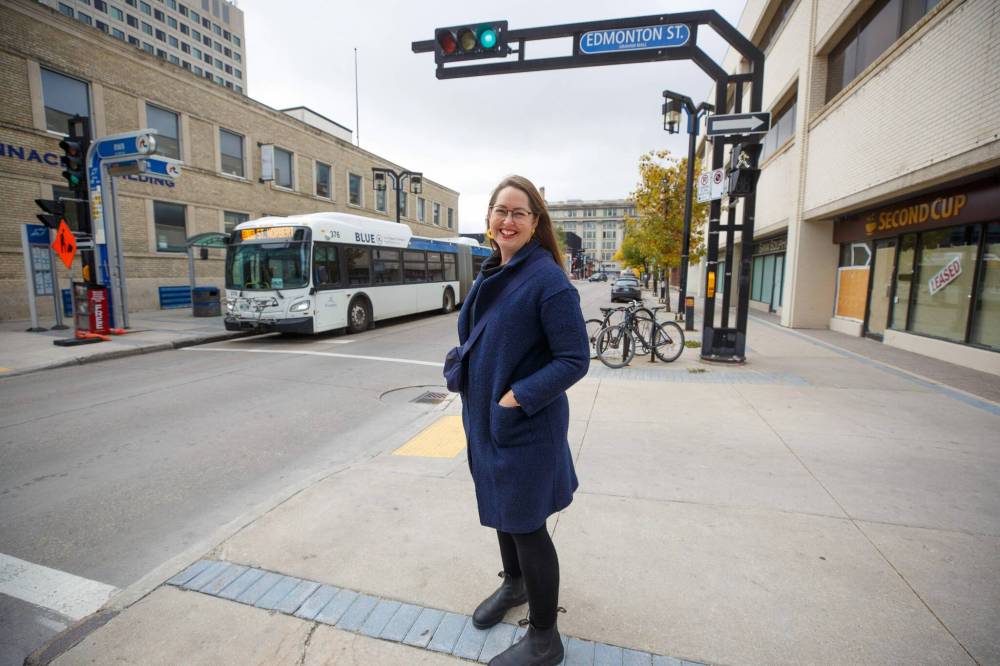
More people might choose to live downtown if there was enough there to hold them. Affordable housing — “truly affordable housing,” Fenske notes, stressing the first word — that could welcome students and artists and low-income families. Enough public spaces and a mix of amenities for a growing, diverse community to fill with its own life.
“Cities across North America and around the world are trying to figure this out,” she says. “What do our downtowns look like coming out of the pandemic? The main thing we’re looking at is, how do we shift from a central business district to more of a social-gathering district, where it can be the place where people connect and want to be?”
In other words, who does Winnipeg’s downtown belong to, and who all should it be for?
Renata Meconse nurses a cup of coffee in the Portage Place food court, gazing over the shuttered kiosks that line its perimeter. There are more vacancies than the last time she visited. In recent weeks, two of the original tenants, Taco Time and Manchu Wok, have closed. Fully half of the food court’s stalls sit empty.
“It’s kind of a shell of what it used to be,” she says with a sigh. “It’s sad.”
To be honest, it’s still bittersweet for Meconse to visit Portage Place and to sit in the food court where her father used to come nearly every day. Joseph Meconse was a fixture here. He was an elder and widely respected veteran, a great bear of a man from Sayisi Dene First Nation. When he died in 2019 at age 77, he left a big hole behind.
And he loved Portage Place, loved the exercise he got walking there, loved the diverse people he met over coffee every day. Of all the warm memories Renata has of her father, some of the ones she cherishes most are the times she would walk through the mall and spot him swapping stories with his friends. It was such a healthy place for him.
MIKE DEAL / WINNIPEG FREE PRESS “It’s kind of a shell of what it used to be,” says Renata Meconse about the empty stalls in the Portage Place food court.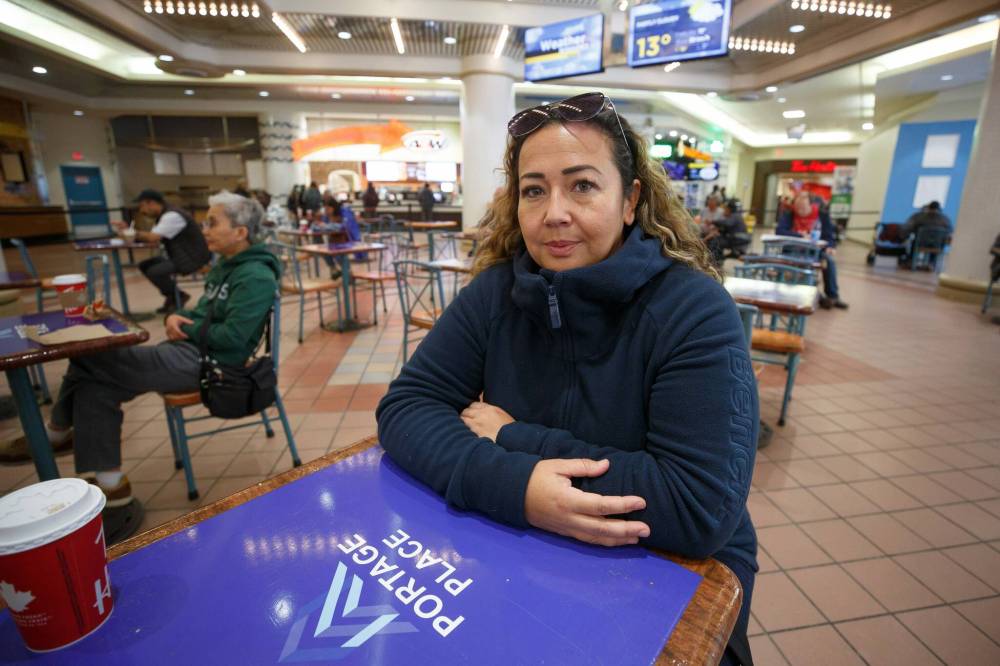
“Otherwise, he would have been sitting at home by himself,” she says. “I can’t express how important that is for seniors who are in their golden years who would otherwise be lonely. I work all day, I couldn’t be with him all day. But being here he was interacting with lots of different people. It was good for him to be here.”
In February 2016, Joseph’s connection to the mall made headlines. One day, he had sat down to eat, when a security guard kicked him out for loitering. The disrespect of a beloved Indigenous elder angered the community. Within a month, Portage Place introduced changes to improve relations with Indigenous people and held a ceremony to honour Joseph.
At the time, Joseph told reporters he was pleased with the outcome. But the incident put a glaring spotlight on a deeper and lingering problem about how the city’s downtown functions.
Almost from the start, Portage Place had fallen far short of developers’ expectations. It never drew the big shopping crowds that they’d hoped. Yet for many who live downtown, particularly seniors, newcomers and Indigenous folk, it soon became a key source of community; a warm, safe and accessible space to meet friends, share coffee and spend the day.
“My dad and I would call it Portage Place First Nation, that was always a little joke,” Renata says, chuckling. “But you would have the community hall on the reserve, the gathering place, and this is one of them in Winnipeg. I know that’s not what it’s meant to be, but… Indigenous people have made this something that they’ve come here for, too.”
MIKE DEAL / FREE PRESS FILES In February 2016, Joseph Meconse was kicked out of the mall by a security guard.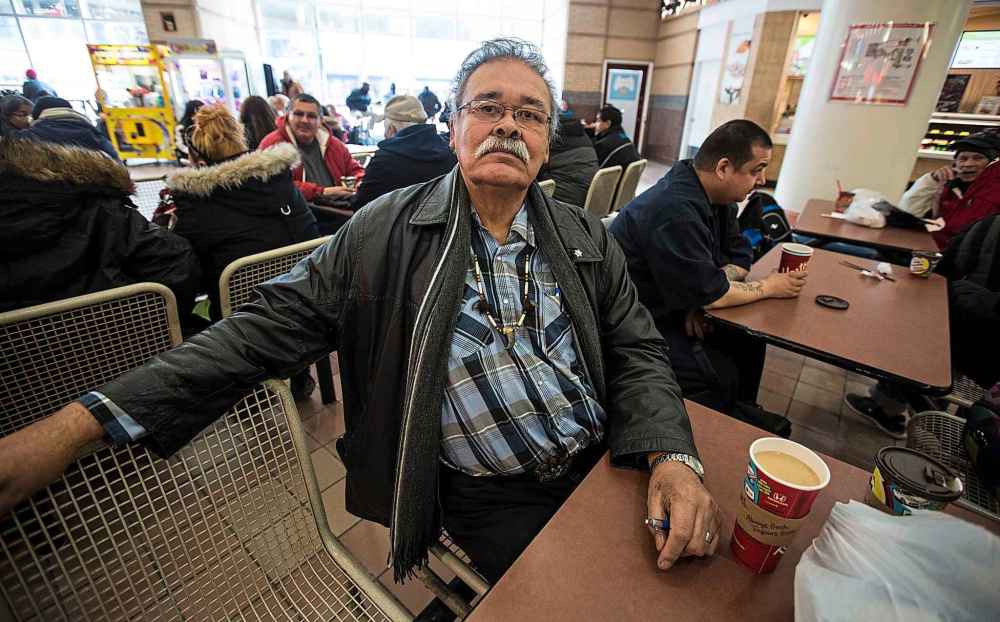
So the real history and purpose of the mall was created by the community that both valued and needed it most, yet as the incident with Joseph showed, they never truly owned it, or had control of how it was governed. Now, as the mall’s long-fading retail life ebbs away, the future of that space — and what will replace it — hangs as an open question.
In many ways, downtown’s future will hinge in part on what happens with Portage Place. Its current owner has long hoped to sell it. In 2021, Toronto-based developer Starlight Investments pulled out of a planned $70-million redevelopment deal. So far, there haven’t been any other investors jumping in to scoop up the troubled asset.
But could there be another way? Last month, a coalition led by the West Broadway Tenants Committee and the Canadian Centre for Policy Alternatives released a vision plan for the mall’s future. It calls for a community-focused redevelopment, one that would include an array of housing options with rents pegged to income and a non-profit gathering space.
The mall has a large footprint; it could host many more amenities than it now does. The vision plan calls for a co-operative grocery, a food bank and an urban garden. It would be supported by an intercultural safety team inspired by the Bear Clan model and have spaces that could host everything from youth arts programs to traditional ceremonies.
“What has happened the last few years with the pandemic, you see the homelessness is magnified… You see so many different things come to light.”–Renata Meconse
Such a transformation would, in a way, simply formalize what has always been true about Portage Place: it belongs to the community in spirit, if not currently in title. It would allow the space to become more flexible and responsive to what the community needs, and how it is evolving.
Renata was one of the people consulted on that vision. She was glad to participate; it’s meaningful for her to advocate for the future of the mall where she still feels so much of her father’s spirit and, by extension, the downtown itself. And she worries about what will happen to those who have relied on it most if their connection to the place isn’t included.
“What has happened the last few years with the pandemic, you see the homelessness is magnified,” she says. “You see so many different things come to light. The addictions — how are we going to address that? What’s this place going to be and where are these people going to go, if Portage Place isn’t going to be a welcoming place?
“So those kind of things need to be considered when it comes to what Portage Place is going to be. Is it going to be sold for the land? Is it going to be torn down? Is the land going to be repatriated or returned to treaty First Nations that still haven’t gotten all their land back? Is that something that they want? Those are questions to ask, too.”
As Renata thinks about her hopes for downtown, something stands out. A common thread, in her vision and Fenske’s.
“All downtowns are supposed to be social places,” she says. “Not places where you come from nine to five and then leave, and then it’s dead downtown and a super-dangerous place that you never want to be. It’s supposed to be a vibrant place that is moving, that has a lot of moving parts. That’s what this place has the opportunity to do. They just have to do it right.”
In the bus shelter in front of Portage Place, 62-year-old Ila sits in her wheelchair with a pleasant smile on her face. Nearby, one of her relatives is sleeping on the bench, drifting in and out of consciousness. When two young street-outreach workers enter the shelter to check on the dozing woman, they cheerfully greet Ila by name. She replies with a familiar nod.
She wants to go to Main Street Project, she tells them. It’s cold now and she needs to find better shoes; the slippers on her feet are too tight and not suited for the weather. The outreach workers offer to call the MSP van to come pick her up, but she demurs. She thinks another one of her relatives is coming to take her there soon.
Ila has been around downtown Winnipeg for a long time. She was born in Gillam, a member of Fox Lake First Nation. Her father died when she was seven years old. Her mother couldn’t care for her, so she was taken away to the city, where she grew up in Wolseley. Despite that disruption, she “never lost her tongue,” she says. She’s a fluent Cree speaker.
For years, Ila has spent much of her days downtown, where she can find enough support to survive. She usually hangs out at Air Canada Park, the plaza on Portage Place’s eastern flank. She knows many of the other people who frequent the plaza, she says, and outreach workers often drop by to distribute sandwiches, which she likes.
JOHN WOODS / WINNIPEG FREE PRESS Tyler Muracz, acting supervisor (right) and John Medina of the Downtown Community Safety Partnership (DCSP) outreach team in downtown Winnipeg.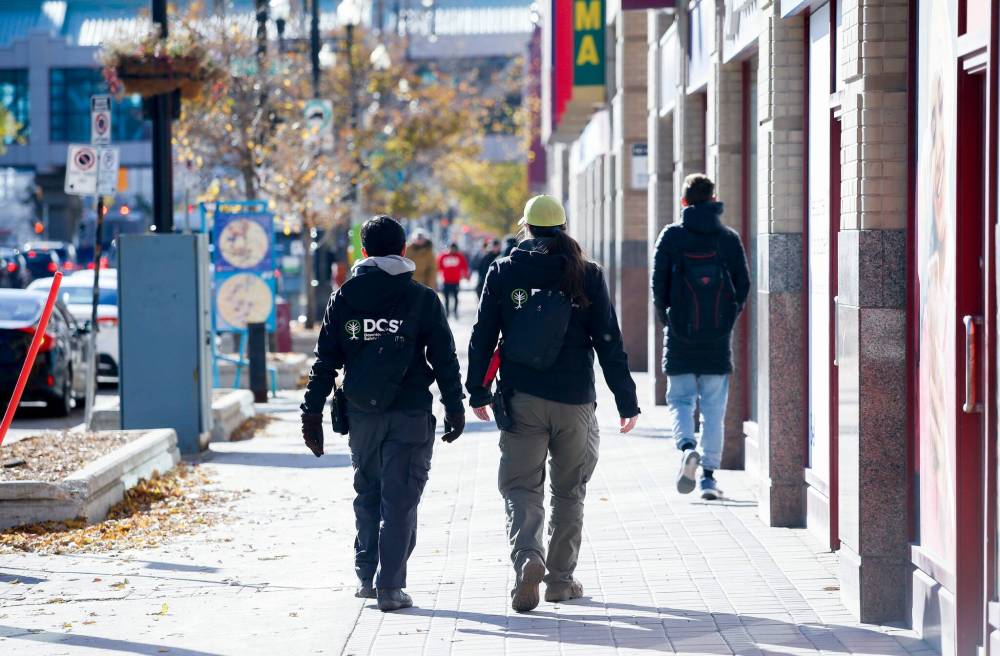
When civic leaders or private investors talk about revitalizing downtown, they don’t usually consider people like Ila and her friends to be stakeholders. They’re not treated as community members with valuable knowledge who ought to be consulted on the area’s future. Usually, they’re treated as one of the problems, the nuisance.
And when public chatter turns to “cleaning up” downtown, it usually means pushing unhoused and other at-risk people out, further to the margins, away from the places they know. The visible challenges many face, including addictions, trauma and mental-health issues, make visitors uncomfortable and afraid which, in turn, keeps those visitors away.
Yet Ila and her friends are a part of the community and, in many ways, they need downtown to thrive more than anyone else. When office workers leave at 5 p.m., Ila and her friends stay. When safety breaks down, it’s the inadequately housed people who are the most vulnerable to the violence. When infrastructure crumbles, they have fewer options to get away.
So I ask Ila how she sees downtown and its challenges. What first comes to her mind is accessibility. It’s difficult for her to cross to the south side of Portage Avenue in her wheelchair, she says. The street’s too broad, and, “I’m too slow.” When I ask her what the biggest change she’s seen downtown over the years is, she nods in the direction of the nearby outreach workers.
“I think it’s that there’s the walkers now that help you,” she says. “That’s a lot of help.”
That’s been the biggest difference she’s noticed over the years? The outreach workers?
“Oh, you better believe it,” she replies. “Sometimes, I feel like I’m just alone by myself. But there’s always somebody there. That’s because the walkers help me out. (That changed) just recently, ‘cause now I know that somebody will help me. Yeah, it’s wonderful.”
“Sometimes, I feel like I’m just alone by myself. But there’s always somebody there. That’s because the walkers help me out.”–Ila
What Ila calls “the walkers” are street outreach teams with the Downtown Community Safety Partnership. Since launching two years ago, DCSP teams have built relationships with unhoused and other vulnerable people who frequent the area, offering everything from first aid to help finding shelter and providing rides wherever participants need to go.
For decades, nearly every conversation about downtown has put safety as a top concern. What was less often specified was whose safety was prioritized and, indeed, who “safety” was even seen to be for. What the DCSP represents is a fundamental shift in that focus, executive director Greg Burnett explains.
“The care, attention, the needs, especially for that at-risk population, there has to be other avenues as a first point of contact, rather than a jail cell or an intoxication facility, or an emergency room if it’s not necessary,” Burnett says. “It’s always people first. You’ve got to deal with people first.… If you’re dealing with crisis all the time, you’re too late.”
JOHN WOODS / WINNIPEG FREE PRESS Greg Burnett, executive director of the Downtown Community Safety Partnership (DCSP) is a former police officer and the Winnipeg Police Service has a member on the DCSP board, along with many grassroots community organizations.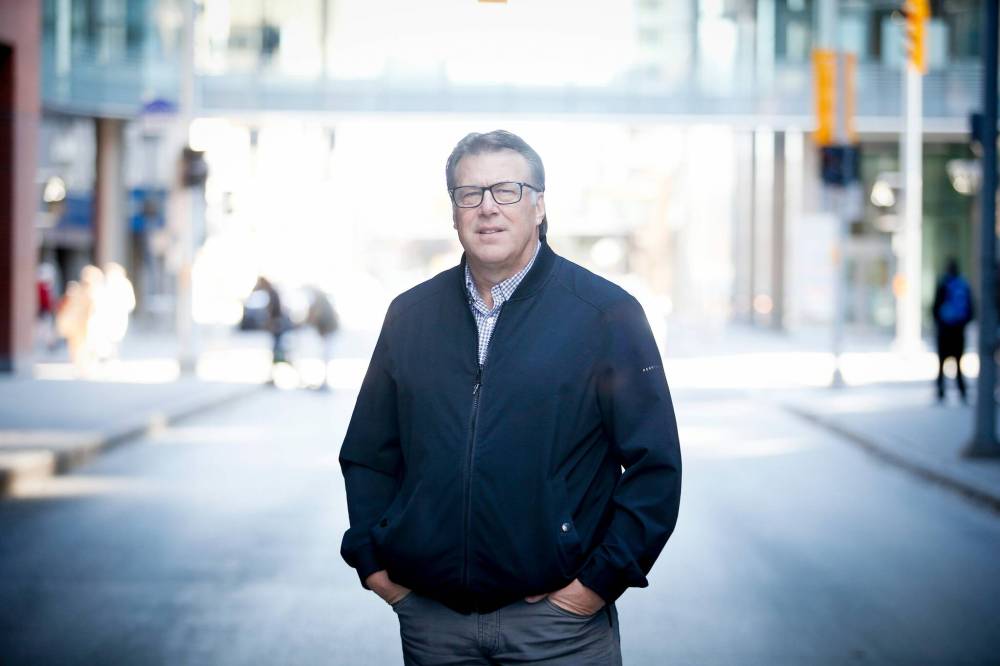
For example, when the DCSP was established, it acquired the Downtown Watch patrol program, which worked closely with police and largely focused on pushing unhoused people out of the area. “It was mostly, ‘You just can’t be here, go somewhere else,’” one former patrol member told me, glumly, of what his work there entailed.
The DCSP is not totally disconnected from police; Burnett is a former police officer and the Winnipeg Police Service has a member on the DCSP board, along with many grassroots community organizations. But when it absorbed the Watch, the primary mission of the walkers was transformed: away from enforcement, towards proactive support.
Gone were the former Watch patrol’s police-like uniforms; gone was their focus on shooing people away from the area. Now renamed the Connect team, their work is to build relationships with everyone who lives or works downtown, find out what’s going on and invite those who need help into the DCSP’s integrated continuum of support.
The partnership is split into three teams that are in constant communication with each other. The Connect team provides the first point of contact; the Mobile Assist and Connect 24/7 team is out on the street day and night offering complex support such as advanced first aid, naloxone to reverse opioid overdoses or trauma-informed care to someone having a mental-health crisis.
“It’s always people first. You’ve got to deal with people first.… If you’re dealing with crisis all the time, you’re too late.”–Greg Burnett
Then there’s the Community Outreach Advocacy Resource team, which takes referrals from the other two teams and helps participants get over the barriers to long-term supports. If people say they want to find housing, the COAR team will help them find housing. If they need to get identification cards to access key social services, the COAR team will help them get the paperwork done.
Every afternoon, the teams meet to review notes about who they’ve met that day and what those people need. By now, they know most of downtown’s regulars by name and the challenges they face; it makes it easier to provide ongoing support and make sure people don’t fall through the gaping cracks in the city’s patchwork social safety net.
That work of caring for people is as varied as the individuals. Workers have to be flexible. On occasion, for instance, DCSP staff have met someone in a bus shelter who has fled spousal violence. To help those people get to a safe place, DCSP workers have driven all over the city, and even deep into rural Manitoba. Wherever they want to go.
“The work they do, meeting people where they’re at, providing those services, is amazing, quite frankly,” Burnett says. “And they’re relentless in the pursuit of finding that help for them. We’re bound by the downtown, but if someone needs that kind of support, or safe space, they go above and beyond to find that for them.”
“The work they do, meeting people where they’re at, providing those services, is amazing, quite frankly… And they’re relentless in the pursuit of finding that help for them.”–Greg Burnett
This approach, one Connect worker tells me, is far more fulfilling than what he did with the Downtown Watch. He’s seen the relationships evolve from fraught to friendly; like Ila, many people are glad to see them. People who were once kicked out of the area now contact DCSP themselves, whether for an urgent need or just wanting a companion to talk to.
“We get calls all the time from folks where it’s just, ‘Help me get here, help me get there,’ and they’ll talk about their lived experiences,” Burnett says. “Sometimes it’s a victim of sexual assault that isn’t ready to go that COAR (long-term support) way and everything else, but we just want to make sure they’re taken care of.
“People feel comfortable talking (with our teams) about some really, really sensitive personal issues.”
Can this approach transform safety downtown, starting from the most vulnerable level up? Burnett believes so. The DCSP keeps detailed data on its work; in time, he believes, it will have concrete evidence for the success of the approach by way of fewer calls to police, fewer calls for ambulances and fewer people experiencing crises downtown.
JOHN WOODS / WINNIPEG FREE PRESS Tyler Muracz, acting supervisor (right) and John Medina of the Downtown Community Safety Partnership (DCSP) outreach team assisting a woman and her two daughters living in a tent in the Millennium Library Park in Winnipeg.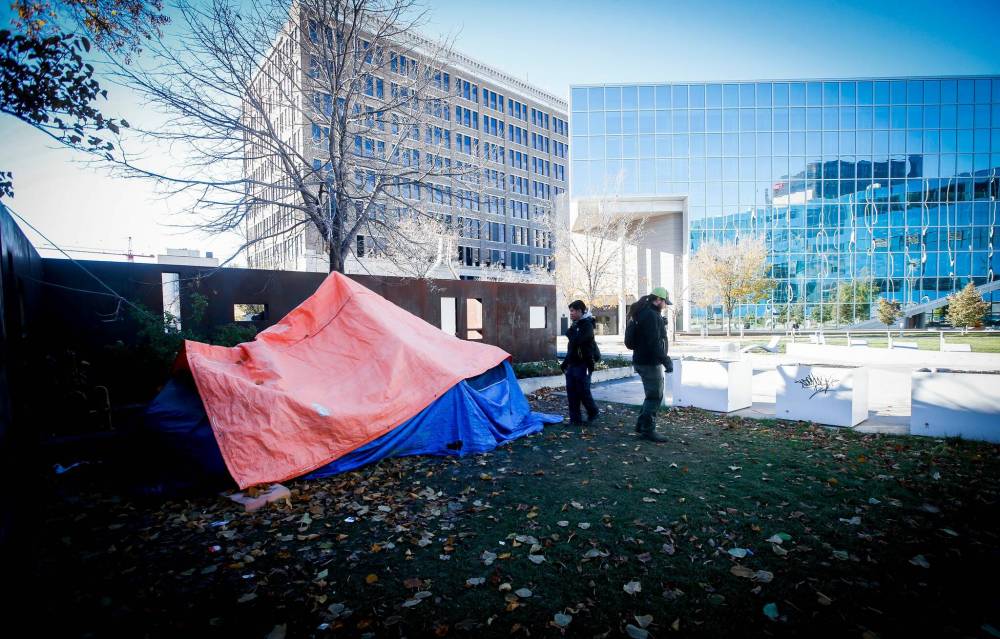
What’s notable in all of these efforts, all of these visions, is that they start at the same place: the health of a downtown isn’t held in its buildings, but in its people. To build a thriving downtown is a conversation between many different facets of the community, and if any of its voices are left out, then the conversation will be irrevocably fractured.
So if Winnipeg’s downtown is ever going to work, it has to work for everybody. It has to work for people who have money and for people who don’t. For people who have an apartment downtown, people who have a house in the suburbs and people who don’t have a house at all. It has to work for students and seniors, workers and tourists and everyone else.
To accomplish that requires balance. It requires both public and private investment and a mix of places where people can find community. It will need cash to fix decaying infrastructure, policy changes to encourage development that will serve a diverse range of people and efforts to make downtown, overall, a healthy and inviting place to be.
JOHN WOODS / WINNIPEG FREE PRESS Tyler Muracz, acting supervisor (foreground) and John Medina of the Downtown Community Safety Partnership (DCSP) outreach team assisting a person on Vaughan St in Winnipeg.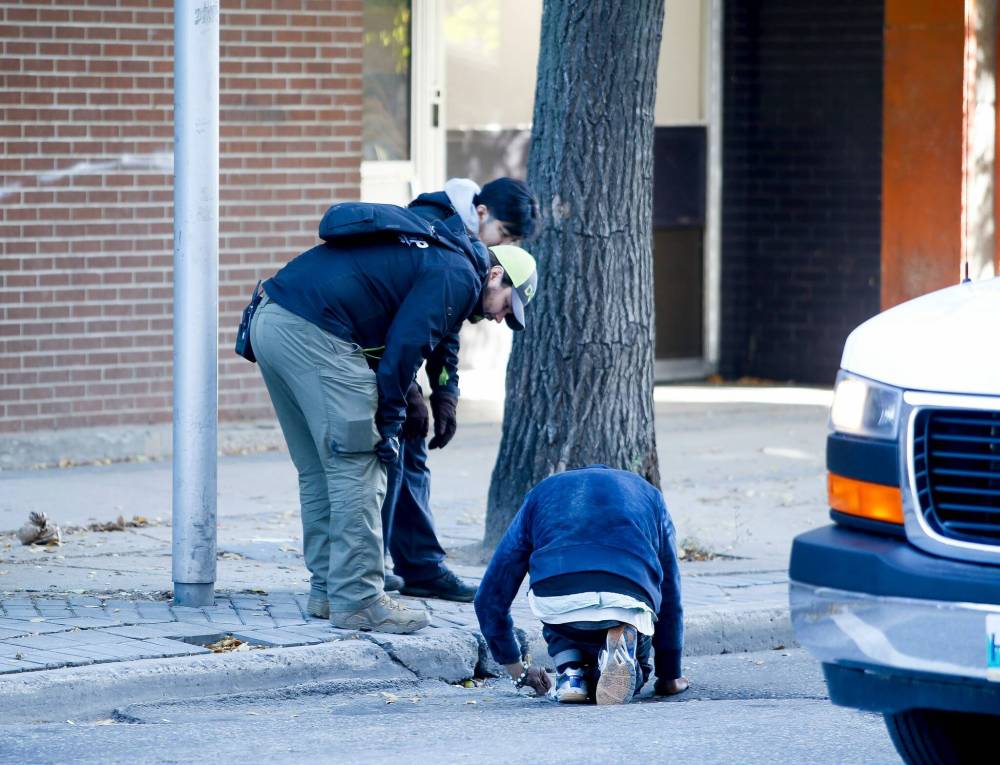
There is an opportunity to create that future. The city is currently doing consultations on its new downtown strategy, which is set to be released within the next two years. The Winnipeg Transit Master Plan, approved in 2021, calls for major shifts to downtown routes, including taking the buses off Graham and adding transit hubs at Union Station and Portage and Main.
Fenske would love to see the transit changes sped up. The new transit hubs will make it easier for people to get in and out of downtown, she says. And removing the bus-only section of Graham opens an opportunity to reimagine that stretch in ways that could foster a more vibrant pedestrian life. Above all, she stresses again, it has to start with people.
“That’s the whole thing, creating the space for people first, and let people decide what they need and how they’re going to use it,” she says. “We have to make sure we have that space available, that we make it beautiful, and safe and comfortable. We’re talking about next year going back to the basics: we need to get recovery, we need to start the transition and the shift.”
melissa.martin@freepress.mb.ca
Our newsroom depends on a growing audience of readers to power our journalism. If you are not a paid reader, please consider becoming a subscriber.
Our newsroom depends on its audience of readers to power our journalism. Thank you for your support.









